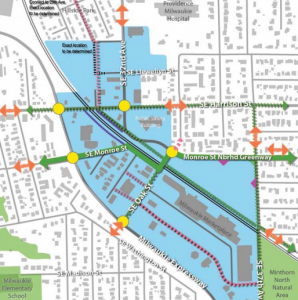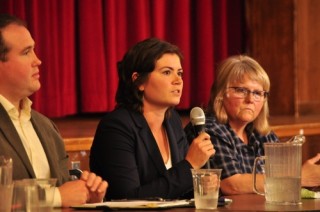
(Image: Milwaukie)
One year after Milwaukie voters elected two vocally bike-friendly politicians to their city council, Milwaukie is lining up some significant investments.
The biggest new one in the works, a crosstown neighborhood greenway on Monroe Street, will get its first public meeting at city council on Nov. 3.
“We have consensus on council to make this a top priority,” Milwaukie City Councilor Karin Power said in an interview Wednesday about the city’s work on an “all-inclusive bike-, pedestrian- and street-safety program.”
Milwaukie doesn’t have a citizen biking or pedestrian advisory committee. But public support for biking and walking improvements has led to something interesting: the city’s public safety committee has broadened its focus and is now taking a lead role on infrastructure planning.
“I think safe streets are safe streets, and that means a lot of things to a lot of different people,” said Power, who came to office last year with strong support from biking supporters, among others. “A lot more of our residents want not just safe streets from a crime perspective but also safe streets with a how-people-are-using-them perspective.”
Advertisement

Councilor Lisa Batey, right.
(Photo: Power campaign)
One of Milwaukie’s biggest challenges, Power said, is State Highway 224, which runs just east of its downtown.
“From my perspective, facilitating a way for people to get across our biggest highways is mission critical,” she said. “ODOT is at the table on that, so that’s helpful for us. I think they’ve recognized that as Milwaukie evolves and is attracting new people and new businesses, we need to knit our neighborhoods together across that highway. It very clearly bifurcates our city, and we have economic areas on both sides.”
“This isn’t just about bikes. It’s about getting kids a way to walk to school, bike to school, get physically active in a safe way. I think that’s part of what’s unified the community on this.”
— City Councilor Karin Power
To that end, the planned Monroe Neighborhood Greenway would include $40,000 for a “diverter, semi-diverter and median refuge islands.”
The Monroe plan isn’t funded yet. That’ll be the next job if Milwaukie’s council approves it.
“This isn’t just about bikes,” Power added. “It’s about getting kids a way to walk to school, bike to school, get physically active in a safe way. I think that’s part of what’s unified the community on this.”
All in all, it’s a huge turnaround from a few years ago ago, when the proposed Orange Line was sometimes derided in Milwaukie as a “crime train” that would cart hoodlums into town.
In her official pitch to voters last year, new Milwaukie City Councilor Lisa Batey described further investments near the Orange Line as the city’s best bet for growing its tax base and eventually funding amenities elsewhere in town. In August, The Oregonian reported that real estate values in Milwaukie were “blowing up” with the opening of the Orange Line.
Power credited the recreational and advocacy group Bike Milwaukie for building popular support for better biking and walking, as well as a “super vocal” network of “moms” at “a number of elementary schools.”
That’s all helped add up to political change, she said.
“With Lisa Batey and I being elected last fall, it was a strong message to council,” Power added.
Correction 4:20 pm: An earlier version of this post gave the wrong title for Councilor Lisa Batey.
— Michael Andersen, (503) 333-7824 – michael@bikeportland.org

